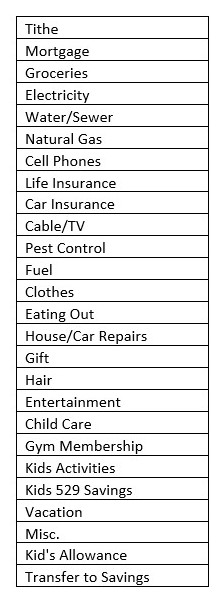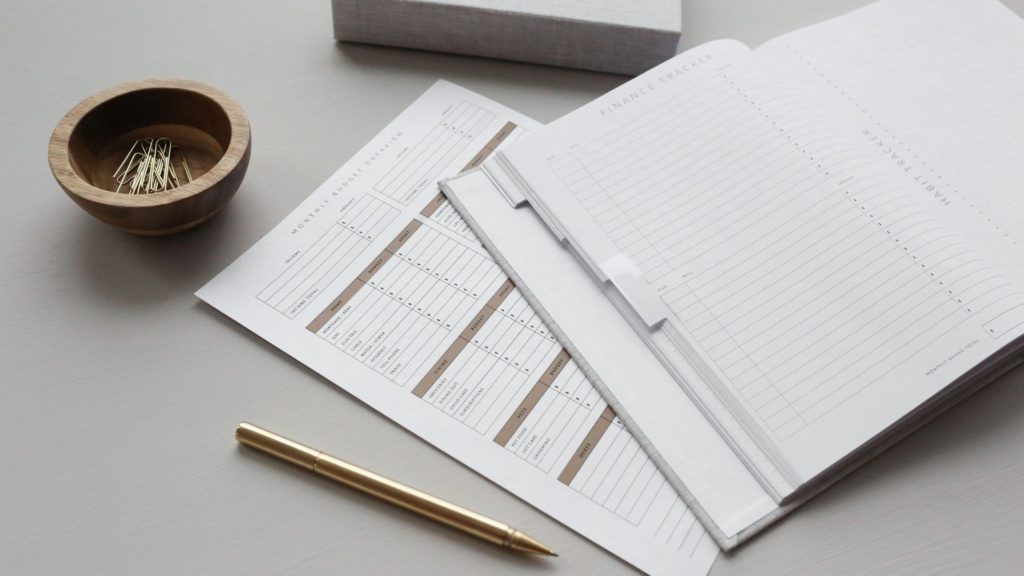Starting Point: 8 Steps to Creating Your First Budget
This is the starting point of the Next Dollar Roadmap; our guide to financial freedom. Along the roadmap, we’ll cover the following topics:
- Starting Point: Creating Your First Budget
- Milestone 1: The Uh-Oh Fund
- Milestone 2: Take Advantage of Your Employer Match
- Milestone 3: Pay Off Toxic Debt
- Milestone 4: Fully Funded Emergency Fund
- Milestone 5: Save 15%-25% of Your Income in Tax-Advantaged Retirement Accounts
- Milestone 6: Save for Flexibility in Bridge Accounts
- Milestone 7: Prefund Kids’ Expenses
- Milestone 8: Pay Off Remaining Debt
- Milestone 9: Total Financial Independence
Budget is not a four-letter word, but for many, it doesn’t exactly stir loads of excitement.
There are few people who look forward to the process of collecting spending records and income statements, then slowly organizing all of the information so you can conduct a series of addition and subtraction only to arrive at the unsurprising fact that it would still be helpful if you had more income.
Maybe I should stop talking about it before you close the browser.
The truth is creating a budget is an absolute necessity for effective financial planning.
Just like that trusty GPS gets you from A to B on the shortest route, you’re going to need a budget to help you take the shortest path to your own financial goals.
Skip this all-important step and you may waste a lot of time lost in a financial wonderland.
5 Benefits of budgeting
Better Understanding of Your Spending Habits
There are many benefits to creating a budget, not the least of which is the opportunity to better understand your spending habits.
If you’re not regularly looking at your spending, chances are you’ll be surprised to see how much you are spending in certain areas.
For example, when my wife and I did our first budget early in our marriage I was shocked to see that we were spending almost as much at restaurants as we were for groceries each month.
We were simply ignorant of the fact because we hadn’t really looked closely at the numbers.
See where you need to adjust
A product of your newfound understanding is our next benefit. It highlights areas where you need to make adjustments to your spending.
Using the eating out example from above, my wife and I knew we needed to evaluate when eating out was actually necessary or beneficial, versus the product of poor planning.
In the end, we decided we wouldn’t eat out alone anymore. Trips to restaurants would only be taken when there was a social benefit that came with it.
Since I was eating out for lunch a lot by myself during the workweek, eliminating this spending brought that budget category back in line with our expectations and our goals.
Communicating with Others
There are few things more frustrating than having teammates that are all working toward different goals. Inevitably, competing goals will lead to headaches, conflict, and very little in the way of actual progress.
If you’re single, this is one aspect of a budget you get to avoid. However, if you have a significant other or dependents who all have a stake in the household budget, you’ll see better results if everyone is unified on your spending goals.
A budget is a very clear way to communicate those expectations as well as providing accountability to everyone involved.
Plus, by working through your spending categories together you have the opportunity to negotiate a budget everyone feels they have a role in.
An Opportunity to Measure Progress
Finally, having a regularly updated budget gives you the opportunity to track your progress and measure success. Most of our financial goals take some time to accomplish.
Having clear evidence your efforts are in fact paying off is critical for maintaining the determination and momentum you need to see them through.
It can also reveal areas where your expectations may not align with reality. For instance, If you had a difficult time hitting your grocery budget for three months straight you can use your previous budget results to adjust spending expectations appropriately.
Now that we’ve covered the benefits, let’s look at the steps to building that budget…
8 Steps to Creating Your First Budget
1) Calculate Your Monthly Income
First, you need to record all your regular income sources. If your monthly take-home pay varies from month to month because you own a business or earn commissions use the lowest paying month from the last year.
If you receive quarterly bonuses or commissions average out the amounts so you arrive at a monthly total.
Ultimately, you don’t want to count on anything you aren’t very confident you will actually receive, so err on the conservative side as you tabulate income.\
2) List ALL the Expenses
The next step is to record all of the expenses you’ve incurred over the last month, and I do mean all. The reason you want to capture every expense is to avoid blind spots in your planning.
The more accurate your expense record is, the more useful your budget is likely to be.
The easiest way to do this is to gather your bank and/or credit card statements and any other documents that record your spending.
Going forward you’ll need to hang on to those receipts if you’re paying cash or at least make a note of the amount you spend and what it was for.
3) Organize Expenses Into Similar Categories
Finally, you get to be a little creative. Your categories can be relatively large or pretty granular if you so choose. Here’s a list of the categories we have in our own budget:

Yes, hair has its own category in our home. My wife’s hair is beautiful. I will provide no further comment at this time.
Again, you should choose categories that make sense to you. I’d counsel you to err on the side of more details so you have a clearer picture of where the money is going.
For example, if you’ve got a $600 budget for food that includes groceries and restaurants you will have a difficult time discerning how much is being spent at the grocery store versus your favorite dining establishment.
This may be important to know so you can adjust your behavior.
You also want to generally group your categories into needs, wants, and savings. This will help you determine where cuts and adjustments can most easily be made.
A common guideline is to use the 50/30/20 rule which basically calls for you to budget 50% to needs, 30% to wants, and 20% to savings. This isn’t a bad starting point, but don’t be afraid to adjust the budget so that it’s working for you.
4) Distinguish Expense Types
Next, go through your list of expenses and distinguish between fixed and variable expenses.
Fixed expenses are the same from month to month. Things like the rent or mortgage, gym membership, internet service, and trash pickup are examples.
Variable expenses are expenses that aren’t quite as predictable and shift from month to month such as electricity, groceries, gasoline, and eating out.
I recommend averaging these expenses over an extended period (up to a year back if possible) to establish a budget line amount.
Go ahead and give yourself some room to miss on these variable expenses a bit. It simply isn’t realistic to expect yourself to predict those expenses with a high degree of accuracy.
5) Set Your Budget
Now that you’ve been through your expenses, ask yourself what stood out.
Were you surprised that you were spending much more or less in any particular area? Were there categories you instantly saw opportunities to reduce or maybe shift dollars from or to? Was the total of your income higher than your expenses?
This is also the time to be sure you’ve included others who have a stake in your budget.
If you expect to use your new budget as a tool to alter spending behavior and reach financial goals faster, you’re going to need to get buy-in from everyone involved.
Go category by category and set realistic spending goals for each one. Don’t be afraid to challenge yourself a bit, but don’t squeeze so tight you don’t leave anything to have a life on.
6) Write It Down
After you’ve established categories and set budgets, you need to record them somewhere so they can be calculated throughout the month.
You can hand write your budget, but there are lots of digital options that might make your life easier.
My first budget was done in Excel. You can add expenses into cells and quickly total them to see how you’re doing. The major negative of this is you have to enter the amounts manually.
About 10 years ago I started using mint.com and I still use it for our household budgeting. It takes a little time to set up, but once the initial work is done it will automatically update your budget every time you access the website or app.
Mint can also track investment accounts, debts, and the value of your home among other things to provide you with a picture of your net worth if you’re interested.
7) Adjust spending to match spending goals
Like any plan, a budget is only a good intention if it isn’t put into practice. Now you’ve got to go out and put this new budget to work so it can start changing your life.
If you made decisions to reduce or eliminate spending anywhere now is the time to take action. Did you decide to drop the gym membership? Eat out less? Drop Netflix? Time to make it happen.
There’s also a chance as you were doing your budget that you simply couldn’t “get the math to work” (a.k.a. – we’re spending more than we make and we have a negative number at the end of the month.)
To borrow a phrase from the late, great Walter Cronkite, “that’s the way it is”.
The math, or the budget, in this case, is an emotionless, unbiased tool that reflects your absolute financial reality (assuming you calculated correctly).
If you cannot afford the lifestyle you have documented in your budget then you have to change one of two things:
- The inflows (offense) – Are there ways to quickly produce more income? Maybe a side hustle or second job? Is there anything you can sell to generate some cash in the meantime? If there’s nowhere to pull more in, then…
- The expenses (defense) – You’re going to have to play better defense. This means everything is on the table, even if it means you have to change where you live.
I know that’s easier said than done, but all the emotion in the world won’t change the math. And if you don’t get the math right now, it will never work for you.
You simply must find a way for your income to exceed your expenses. If you take nothing else away from this post, please remember that.
I recall a co-worker that was trying to lose weight but was frustrated by the lack of progress. She was working out more often and said she was eating better, but just couldn’t get her weight down.
As we talked more about it, she confessed that she was allowing herself a few “cheat” meals each week.
Her go-to cheat meal? A Big Mac and fries from McDonald’s! (That’s 1,080 calories for those of you scoring at home).
I’m not one to judge. Sometimes fast food just hits the spot, but the fact is by allowing “cheats” she wasn’t giving herself an accurate picture of her dietary reality.
The result was a lack of progress and an abundance of frustration.
If you fail to take your budgeting seriously, you may find yourself in a very similar situation.
8) Review your budget regularly
Finally, you need to review your budget regularly.
I once went on a diet to lose a few pounds and ended up losing around 30 over the course of 4 months. I was surprised how much of the success was dependent upon consistent tracking of my calories.
Once I reached my goal I stopped tracking what I was eating and you’ll never guess what happened!
I started gaining weight☹.
Thankfully, I didn’t gain it all back, but without that consistent measurement, I wasn’t sure exactly how much I was eating each day.
As you start out be sure to update your budget at least every 2-3 days. That way it’ll always be fresh on your mind.
When you’re asked to go out for a bite with friends, you’ll know quickly whether or not you’ve got the funds left in that category.
If you wait until the end of the month to update the budget, you’ll have missed your opportunity to change anything.
As time goes on your lifestyle will hopefully settle into healthy financial routines that drive you toward your goals. You’ll always need to keep an eye on the budget, but maybe not have to watch it as closely down the road.
Next stop, Milestone 1: The Uh-Oh Fund.







